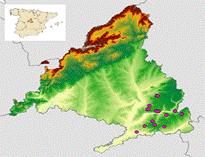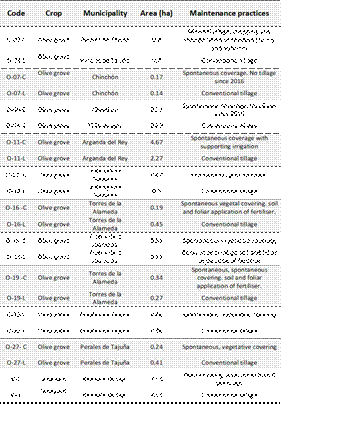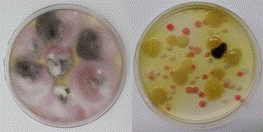INTRODUCTION
Tillage is the main soil management of olive tree groves in the Community of Madrid (>71%), as in other Spanish regions (MAPAMA, 2019). This practice leads to soil erosion with a significant loss of organic carbon and nutrients (Gómez et al., 2009; Marques et al., 2020). It directly and indirectly influences soil properties related to water retention and availability, as well as its biological properties. Maintenance techniques for woody crops in the Madrid region, as in the rest of Spain, vary according to the crop. The Community of Madrid has an area of woody crops of approximately 62.069 ha, of which 23.816 ha are maintained with traditional tillage, 28.859 ha with minimum tillage, 94.558 ha with spontaneous plant coverings and the remaining hectares have no maintenance at all (MAPAMA, 2019). Olive groves in the Mediterranean basin are usually managed with continuous tillage and low organic matter inputs, which leads to several soil degradation processes.
Alternative soil conservation practices prevent soil and nutrient loss and slows down physical soil deterioration, which can indirectly compromise water availability for crops, especially in regions with semi-arid climates such as Las Vegas in Madrid region. Among them, cover crops have emerged as an alternative soil management strategy to improve soil fertility, the amount of organic matter and the sustainability of agroecosystems. Permanent or annual cover crops, sown or spontaneous, and mulching are strategies to protect the soil from erosive processes (Sastre et al., 2018; FAO & ITPS, 2021) in addition to improving the abundance and function of the soil microbial community related to soil biogeochemical cycles. However, farmers are still unwilling to apply cover crops or reduce the frequency of tillage. Therefore, it is essential to perform studies that confirm the benefits of this practice.
Water is a key factor to consider in crop production, especially for crops grown in the Mediterranean Basin. Therefore, the aim of this study was to evaluate the effect of different maintenance practices (tillage and mulching) in woody crops on soil parameters related to water availability and how these changes modulate the abundance of fungus and bacteria.
MATERIAL AND METHODS
The study was carried out in the region of Las Vegas, located in the Southeast of the Community of Madrid, Spain, with large areas of woody crops (mainly olive groves). The climate was classified as continental Mediterranean, with a mean annual temperature of 14.7ºC, a cumulative annual rainfall of 370 mm, and a reference evapotranspiration (ET0 Penman-Monteith) of 1170 mm. Twelve plots with traditional tillage and 12 plots in close proximity with the same soil and crop, but with alternative management (soil conservation practices), were selected.
The plots with traditional tillage were identified with the letter L, whereas those with alternative management (mulching) whith C. For example, code O3-L means olive grove, plot 3, and traditional tillage whereas VO3-C vineyard with olive grove, plot 3 and coverage (Table 1). Figure 1 shows the geographical distribution of the plots. The soils of the plots were classified as Calcisols, Cambisols, Luvisols, Leptosols (according map to FAO map, Comunidad de Madrid, 1990).

Figure 1 Location of plots in Madrid Region (n=12 each dot consists of a pair of plots: soil conservation management and tillage.
In each plot, three composite samples were taken at a 0-10 cm depth. The samples were subdivided into two parts, one part was stored at 6°C for biological analyses (bacterial and fungal biomass determination) and the other part was air-dried and sieved at 2 mm to determine pH, electrical conductivity and total organic carbon (TOC) In addition, undisturbed samples were taken in stainless steel cylinders (100 cm3 and 5 cm high) at a 0-10 cm depth to determine physical parameters related to soil water retention (permanent wilting point-PMP-, field capacity-CC-, total porosity-TP-, micro, meso and macroporosity, bulk densit-/BD-, and water stable aggregates/WSA). Microbial biomass was estimated by plate count of isolated colonies on specific culture media
for bacteria (Nutrient Agar) and fungi (Potato Dextrose Agar) after incubation at 25°C for 48h for bacteria and 72h for fungi (Varghese and Joy, 2014) (Figure 2). Cylinder samples were saturated with water by capillary action in a sandbox to determine pF between 0 and 2.0 (0.1 to 10 kPa respectively) by successive weight measurements. Water retention between 2 and 4.2 pF (10 to 1500 kPa respectively) was determined by a progressive drying process with pressure plate extractors (Richards, 1941). Finally, the samples were dried completely in an oven (24 h at 105 °C) corresponding to pF 7 (106 kPa). The weight of these dried samples also allowed the determination of the soil BD (Blake and Hartge, 1986). The relationship between pore size and water holding capacity was established as follows: macropores (>60 µm) corresponded to matrix potentials between pF 0 and 1.8; mesopores (60 to 10 µm) to pF values between 1.8 and 2.54; and micropores (<10 µm) to pF > 2.54. Pores smaller than 0.2 µm in diameter corresponded to matrix potentials higher han pF 4.2.. The available water capacity (AWC) was determined by the difference between the volumes of water.
A multivariate analysis (Partial Least Squares Regression -PLS-) was performed to assess the relationship between bacterial and fungal biomass (Y) and a set of soil variables (X). This technique generalises and combines principal component analysis (PCA) and linear regression analysis in order to describe the interactions of bacterial and fungal biomass with soil parameters related to water retention and to quantify the common variation in the data. This analysis was done using InfoStat software (Di Rienzo et al., 2020).
RESULTS AND DISCUSSION
The multivariate analysis (PLS) indicates that the variability of the data is explained by 76.7% (Figure 3). It also shows the interaction of edaphic variables with the abundance of bacterial and fungal biomass. The edaphic variables that showed the highest projection on the main axis were TOC, BD, PMP, macroporosity and mesoporosity, and those with the lowest projection were WSA and micropores, indicating that TOC, BD, PMP, macroporosity and mesoporosity were the edaphic parameters that mainly interacted with bacterial and fungal biomass. Figure 3 displays the distribution of the plots. The distribution of fungi and bacteria in the different plots (blue dots) is grouped approximately in three or four groups, with the plots within the same group being very similar to each other and different between groups. Bacteria stood out in O7-C and V1-C while fungi stood out in V1-C and were statistically similar to O3-C and O3-L (Tukey test). Bacteria showed a significant positive relationship with fungi and a negative relationship with PMP, but were not significantly related to TOC. However, fungi showed a positive and significant relationship with TOC, mesopores and a negative relationship with BD, indicating the importance of these parameters in explaining bacterial and fungal distribution in soil.

Figure 3 Triplot of the correlation between bacterial biomass, fungal biomass and soil variables interaction matrix
In summary, water availability in the soil, especially the permanent wilting point, affected the abundance of bacteria, but did not affect the fungal biomass, which could be explained by the fact that fungi have specific structures (mycelium) that allow them to explore a larger soil surface and thus reach sites that bacteria cannot explore due to their unicellular structure. Fungi responded positively to TOC, but were negatively affected by soil BD. Considering that most of the plots studied have clay loam or silt loam soils, we believe that increases in soil BD could be related to the continuous and prolonged use of tillage, which can break down the fungal mycelium and, consequently, affect the abundance of this microbial group.
















